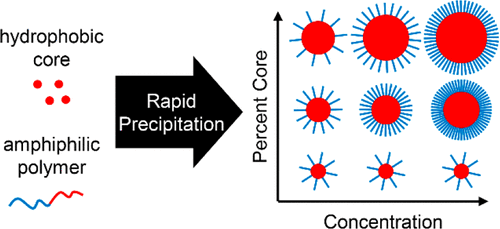当前位置:
X-MOL 学术
›
Nano Lett.
›
论文详情
Our official English website, www.x-mol.net, welcomes your feedback! (Note: you will need to create a separate account there.)
Controlling and Predicting Nanoparticle Formation by Block Copolymer Directed Rapid Precipitations
Nano Letters ( IF 10.8 ) Pub Date : 2018-01-10 00:00:00 , DOI: 10.1021/acs.nanolett.7b04674 Robert F. Pagels 1 , Jasmine Edelstein 1 , Christina Tang 1, 2 , Robert K. Prud’homme 1
Nano Letters ( IF 10.8 ) Pub Date : 2018-01-10 00:00:00 , DOI: 10.1021/acs.nanolett.7b04674 Robert F. Pagels 1 , Jasmine Edelstein 1 , Christina Tang 1, 2 , Robert K. Prud’homme 1
Affiliation

|
Nanoparticles have shown promise in several biomedical applications, including drug delivery and medical imaging; however, quantitative prediction of nanoparticle formation processes that scale from laboratory to commercial production has been lacking. Flash NanoPrecipitation (FNP) is a scalable technique to form highly loaded, block copolymer protected nanoparticles. Here, the FNP process is shown to strictly obey diffusion-limited aggregation assembly kinetics, and the parameters that control the nanoparticle size and the polymer brush density on the nanoparticle surface are shown. The particle size, ranging from 40 to 200 nm, is insensitive to the molecular weight and chemical composition of the hydrophobic encapsulated material, which is shown to be a consequence of the diffusion-limited growth kinetics. In a simple model derived from these kinetics, a single constant describes the 46 unique nanoparticle formulations produced here. The polymer brush densities on the nanoparticle surface are weakly dependent on the process parameters and are among the densest reported in the literature. Though modest differences in brush densities are observed, there is no measurable difference in the amount of protein adsorbed within this range. This work highlights the material-independent and universal nature of the Flash NanoPrecipitation process, allowing for the rapid translation of formulations to different stabilizing polymers and therapeutic loads.
中文翻译:

通过嵌段共聚物定向快速沉淀控制和预测纳米颗粒的形成
纳米颗粒已在包括药物输送和医学成像在内的几种生物医学应用中显示出了希望。然而,从实验室到商业化生产的纳米颗粒形成过程的定量预测一直缺乏。快速纳米沉淀(FNP)是一种可扩展的技术,可形成高负载,嵌段共聚物保护的纳米颗粒。在此,显示了FNP工艺严格遵守扩散受限的聚集组装动力学,并显示了控制纳米粒子尺寸和纳米粒子表面上聚合物刷密度的参数。粒径范围为40至200 nm,对疏水性封装材料的分子量和化学组成不敏感,这是扩散受限的生长动力学的结果。在源自这些动力学的简单模型中,一个常数描述了此处生产的46种独特的纳米颗粒配方。纳米颗粒表面上的聚合物刷密度与工艺参数之间的相关性很弱,并且是文献中报道的最密集的密度。尽管在刷子密度上观察到适度的差异,但是在此范围内吸附的蛋白质数量没有可测量的差异。这项工作突显了Flash NanoPrecipitation工艺的材料无关性和通用性,可将制剂快速转化为不同的稳定聚合物和治疗负荷。纳米颗粒表面上的聚合物刷密度与工艺参数之间的相关性很弱,并且是文献中报道的最密集的密度。尽管在刷子密度上观察到适度的差异,但是在此范围内吸附的蛋白质量没有可测量的差异。这项工作突显了Flash NanoPrecipitation工艺的材料无关性和通用性,可将制剂快速转化为不同的稳定化聚合物和治疗负荷。纳米颗粒表面上的聚合物刷密度与工艺参数之间的相关性很弱,并且是文献中报道的最密集的密度。尽管在刷子密度上观察到适度的差异,但是在此范围内吸附的蛋白质数量没有可测量的差异。这项工作突显了Flash NanoPrecipitation工艺的材料无关性和通用性,可将制剂快速转化为不同的稳定化聚合物和治疗负荷。
更新日期:2018-01-10
中文翻译:

通过嵌段共聚物定向快速沉淀控制和预测纳米颗粒的形成
纳米颗粒已在包括药物输送和医学成像在内的几种生物医学应用中显示出了希望。然而,从实验室到商业化生产的纳米颗粒形成过程的定量预测一直缺乏。快速纳米沉淀(FNP)是一种可扩展的技术,可形成高负载,嵌段共聚物保护的纳米颗粒。在此,显示了FNP工艺严格遵守扩散受限的聚集组装动力学,并显示了控制纳米粒子尺寸和纳米粒子表面上聚合物刷密度的参数。粒径范围为40至200 nm,对疏水性封装材料的分子量和化学组成不敏感,这是扩散受限的生长动力学的结果。在源自这些动力学的简单模型中,一个常数描述了此处生产的46种独特的纳米颗粒配方。纳米颗粒表面上的聚合物刷密度与工艺参数之间的相关性很弱,并且是文献中报道的最密集的密度。尽管在刷子密度上观察到适度的差异,但是在此范围内吸附的蛋白质数量没有可测量的差异。这项工作突显了Flash NanoPrecipitation工艺的材料无关性和通用性,可将制剂快速转化为不同的稳定聚合物和治疗负荷。纳米颗粒表面上的聚合物刷密度与工艺参数之间的相关性很弱,并且是文献中报道的最密集的密度。尽管在刷子密度上观察到适度的差异,但是在此范围内吸附的蛋白质量没有可测量的差异。这项工作突显了Flash NanoPrecipitation工艺的材料无关性和通用性,可将制剂快速转化为不同的稳定化聚合物和治疗负荷。纳米颗粒表面上的聚合物刷密度与工艺参数之间的相关性很弱,并且是文献中报道的最密集的密度。尽管在刷子密度上观察到适度的差异,但是在此范围内吸附的蛋白质数量没有可测量的差异。这项工作突显了Flash NanoPrecipitation工艺的材料无关性和通用性,可将制剂快速转化为不同的稳定化聚合物和治疗负荷。



























 京公网安备 11010802027423号
京公网安备 11010802027423号